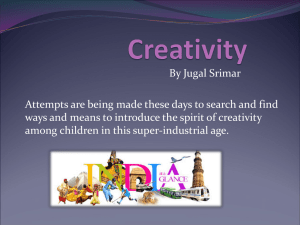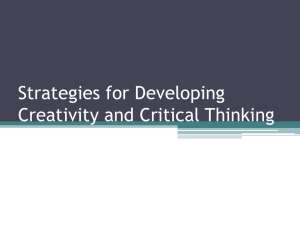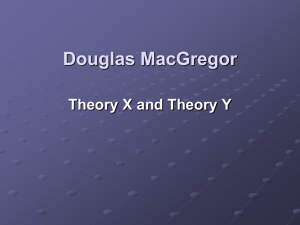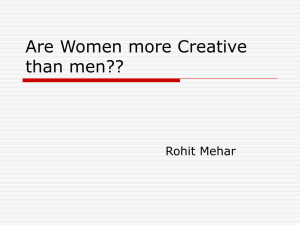Creativiti - Idea menulis
advertisement
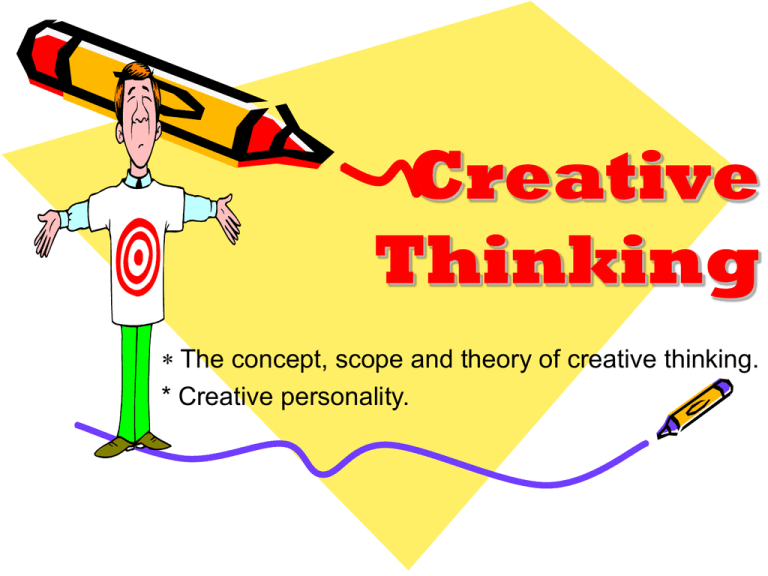
Creative Thinking The concept, scope and theory of creative thinking. * Creative personality. Etimology • Creare (to create); ‘krainein (to fulfill). • 16, 17 & 18 century (sciences, art, literature, poem, novel etc.). • 19th century - Creatum/Create (to produce/to make) – (the finished product) vs (an ongoing process). Creativity Create > creativity; creative thinking Creative thinking is “the ability to bring something of new existence.” (Webster’s Dictionary 1976) “Creativity is the making of new and rearranging of the old.” (Mike Vance, 1995) “Being creative is seeing the same thing as everybody else but thinking of something different.” (Wycoff, 1995) “Something or some process that is original, novel, newly thought of, and in some cases as being useful.” (Amabile, 1999) “Looking at what everybody else is looking but thinking of what nobody else has thought” (A.S Goyrgy) “Bringing together ideas that were previously unrelated” “The process of producing something is both original & worthwhile” (Sternberg, 1996) “Bringing together ideas that were previously unrelated” David Perkins (1996) “An idea is creative if that person (the creator) could not have had that idea before.” Margaret Boden (1990) “Creativity is the ability to produce work that is novel (original, unexpected), high in quality and appropriate (Lubart, 1994; Osche 1990; Sternberg 1999) “Creativity is extra/ordinary, original and fitting, full-filling, in(ter)ventive, co-coperative, un/conscious, fe/male, re…creation.” (Rob Pope, 2005) CREATIVE THINKING CRITICAL THINKING ORDINARY THINKING Creativity approaches • Mystical approaches • Pragmatic approaches • Psychodynamic approaches • Psychometric approaches • Cognitive approaches • Social-personality approaches • Confluence approaches (Sternberg & Lubart, 1999) Mystical approaches • Associate to mystical belief and spirituality; e.g. ‘Daemon’ inside the writer’s pen. • Creative person = empty vessel (a divine would fill with inspiration). • Without ‘scientific spirit’. Pragmatic approaches • Lacking of (or no) scientific study (psychological theory) while focus on the commercial success. • e.g. Edward de Bono who concern on the practice, not the theory, Osborn (brainstorming), von Oech (role adopting) etc. Edward de Bono (1) • Popular with ideas and concepts of lateral thinking (vs. vertical thinking), PMI, PO (provocative operation = hypothesis, suppose, possible & poetry), Six Hats (green hat > creative). • de Bono: Do not ever say TINA (there is no alternatives). Edward de Bono (2) • Books: – I am Right You Are Wrong (1990). – Handbook for the Positive Revolution (1991). – Six Action Shoes (1992). – Serious Creativity (1992). – Sur/petition (1992) etc. Psychodynamic approaches • Creativity arises from the tension between conscious reality and unconscious drives. • However it is still lacking of scientific spirit, more rely on case study. Psychometric approaches • Unusual Uses Test, Torrance Tests of Creative Thinking etc. Cognitive approaches Social-personality approaches Confluence approaches Creativity exercises • List 20 usages of: • paper clip • ball-pen. • Anagram games. Creativity & IQ • Many creative persons have average IQs; no correlation between ‘intelligence’ and ‘creativity’. Creativity & academic achievement (1) • Extensive scientific studies since 1960s. • Getzel & Jackson (1958, 1962): High creative + high IQ = ‘overachieve’ for their intelligence. • Influences of gender, SES, nature of creativity & academic avhievement, intelligence. Creativity & academic achievement (2) • Cicirelli (1965): The relationship between creativity and academic achievement was LOW. Creativity & families (1) • Major scope of variables (time-base development): Family tree/genetic, family history (parental loss, family crises etc.) and family climate (parenting style etc.). • No clear evident on heritability of creativity. • Writers, in particular, sought less social companionship as children. Creativity & families (2) • Family history findings: Father loss, firstborn, humor and play at home etc. • Family climate findings: ‘Unisex’ role, distressful family, independence from parent (especially mother) etc. • Csikszentmihalyi: Even 20% females & 30% males of subjects loss father, families supported & nurtured children’s selfconfidence. Families families exposed them to a stimulating & rich environment. TYPES of CREATIVITY H – Creativiti (C) (20 – 40 years old) S – Creativity (c) Boden (1998) • • • • BIG C Sublime creativity Kreativiti agung Kreativiti primer • Small c • Everyday creativity • Minor creativity FUNCTION of CREATIVITY IDEA DISCOVERY INNOVATION DECISION MAKING INVENTION PROBLEM SOLVING Pseudo creativity SOURCES of CREATIVITY • • • • • • GOD Knowledge Experiences & skills Readings Environment Creative figures 3 2 1 Csikszentmihalyi: What we call creativity is constructed through and interaction between producers and audiences. Creativity is not the product of single individuals, but of social systems making judgements about individuals’ product. The word success is an ambiguous word. Success with respect to the outside? Or success with respect to oneself? And if it is a success with respect to the outside, then how do you evaluate it? Very often outside success is irrelevant, wrong, and misplaced. So how can one talk about it? Externally, you may think I am successful because people write about some aspects of my work. But that is an external judgment. And I have no idea as to how to value that judgment. Success is not one of my motives. Because success stands in contrast to failure. But not worthwhile effort in one’s life is either a success or a failure. What do you mean by success? You take a problem and you want to solve it. Well, if you solve it, in a limited sense it is a success. But it may be a trivial problem. So a judgment about success is not something about which I’ve ever been serious about in any sense whatever.” (Subrahmanyan Chandrasekhar, the Nobel laureate physicist; American; he wrote The Mathematically Theory of Black Holes (1983), Creative personality (1) • ‘Minnesota Multiphasic Personality’ by Frank Barron (1969). • ‘The Psychoticism Scale of the Eysenck Personality Questionnaire’ by Eysenck (1995). • Robert Alan Black and 32 Traits of Creative People. Creative personality (2) • John Bardeen. • Bill Gates. • etc.

